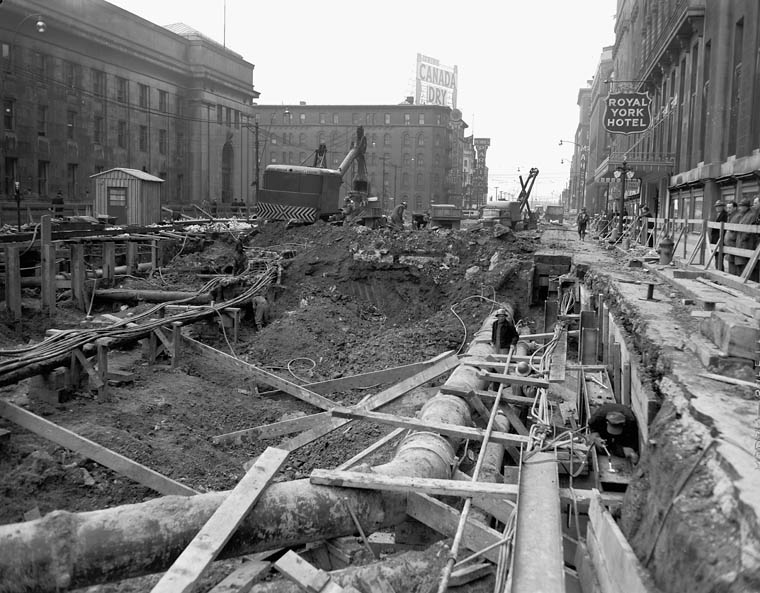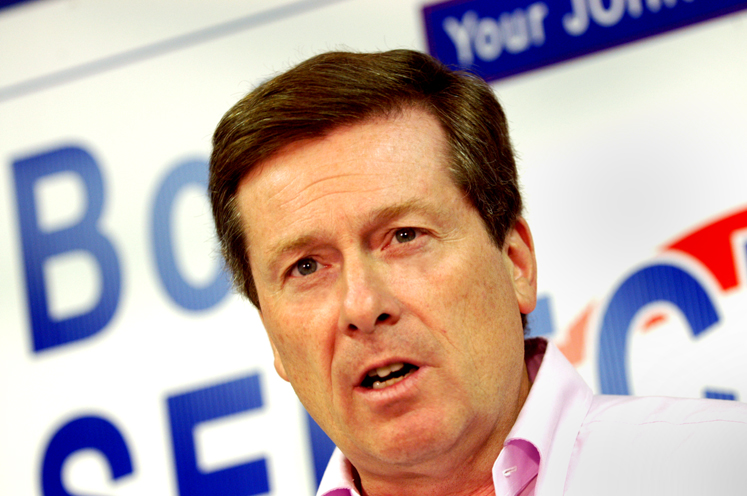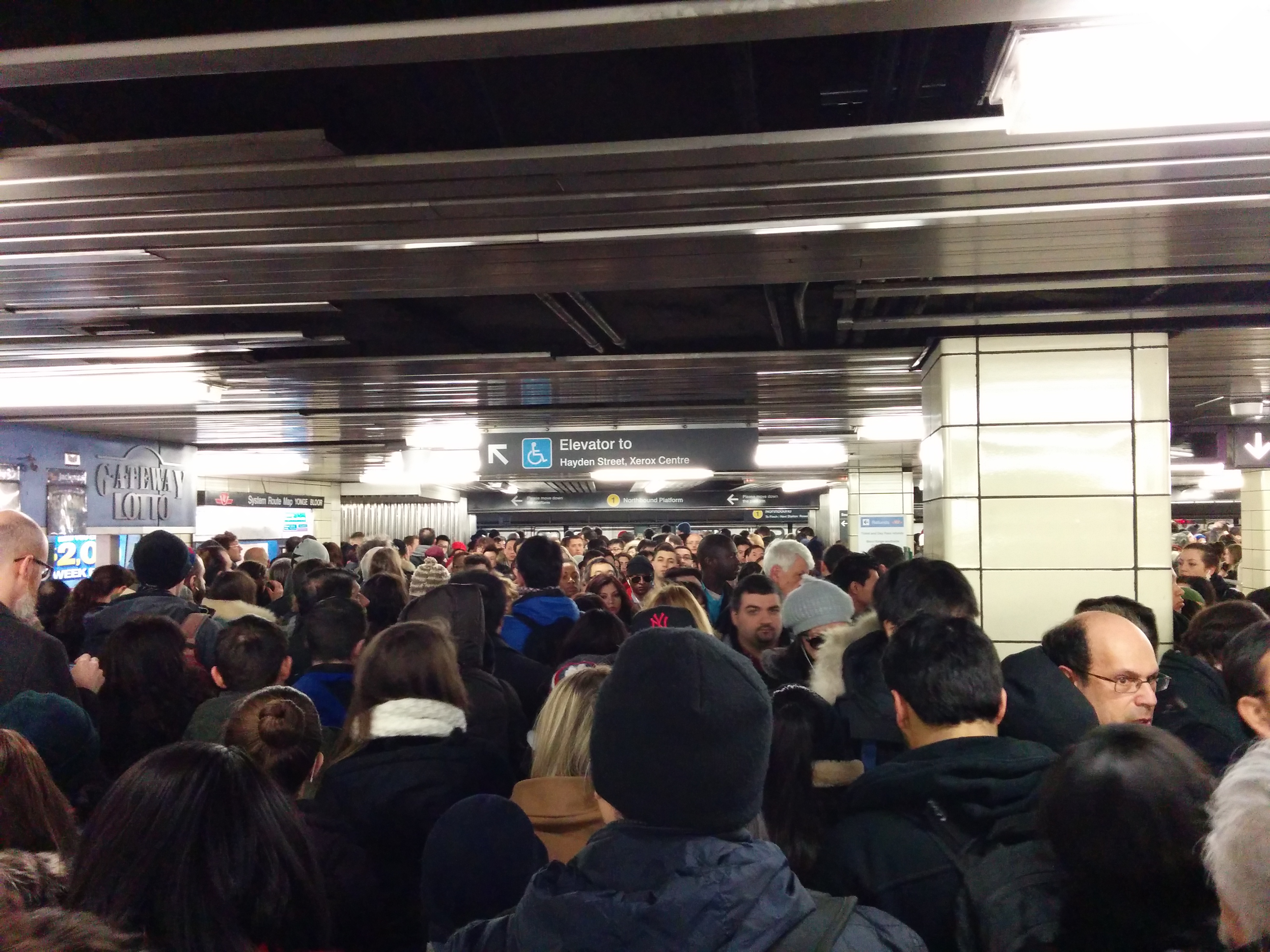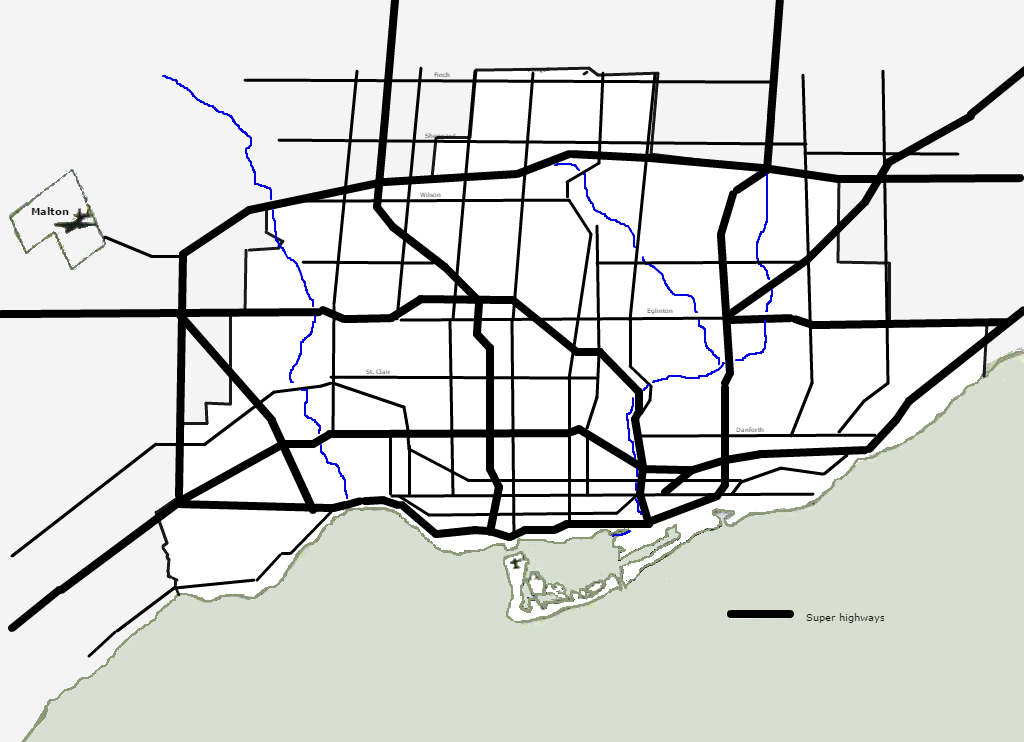|
SmartTrack
SmartTrack is a municipal proposal to enhance GO Transit rail service within Toronto, Ontario, Canada. It takes advantage of the province's existing GO Transit Regional Express Rail plans. SmartTrack has evolved since it was originally proposed by Toronto mayor John Tory as the centrepiece of his 2014 mayoral election campaign. Originally, SmartTrack was to be a new rapid transit service with 22 stations (of which 14 would be new) along the inner portions of the Kitchener, Lakeshore East and Stouffville GO commuter train corridors. As of 2021, SmartTrack is a proposal to construct five new GO stations along the existing Kitchener, Lakeshore East, Stouffville and Barrie services. Original proposal SmartTrack was first proposed during John Tory's 2014 campaign for mayor. It had been changed with proposals made by city staff after Tory assumed office. The SmartTrack line as proposed would be long and run along Eglinton Avenue from Matheson/Airport Corporate Centre in Mississau ... [...More Info...] [...Related Items...] OR: [Wikipedia] [Google] [Baidu] |
Line 5 Eglinton
Line 5 Eglinton (also known as the Eglinton Crosstown or the Crosstown) is a light rail line that is under construction in Toronto, Ontario, Canada. Owned by Metrolinx and operated by the Toronto Transit Commission (TTC), the line will be part of the Toronto subway system as its fifth route. The first phase of the line will include 25 stops along Eglinton Avenue, from Mount Dennis station underground to station, after which it will run predominantly at-grade within the street's median to Kennedy station, where it will connect underground with Line 2 Bloor–Danforth and Line 3 Scarborough. The line was conceived in 2007 during the administration of Toronto mayor David Miller as part of Transit City, a large-scale transit expansion plan. Construction of the first phase of the line began in 2011 and was originally expected to be completed in 2020; it has been delayed more than once, and as of November 2021, Metrolinx and Crosslinx (the construction consortium) agreed on an open ... [...More Info...] [...Related Items...] OR: [Wikipedia] [Google] [Baidu] |
Mount Dennis
Mount Dennis is a neighbourhood in Toronto, Ontario, Canada. It is within the former suburb of York, now Ward 11 in Toronto. Primarily located along Eglinton Avenue between the Humber River and the Kitchener commuter rail line, the neighbourhood was best known for Kodak Heights, once a major film manufacturing facility owned and operated by the Eastman Kodak Company. According to the 2016 Toronto Ward 11 Census, 62,620 residents are in the area, with a median age of 39.3 as of 2016, and a population growth of over 0.4% as of 2016. 24, 895 households are in Ward 11, and 230 net new households were built in 2016. A total of 31,125 of 62,620 are immigrant populations as of 2016. Unemployment rate is 9.5% in Ward 11 as of 2016, with an average household income of $66,447 and is much lower than Toronto's average of $102,721 as of 2016. Average rent price is $940/month as of 2016's census as well. History The area gets its name from the Dennis family (led by John Dennis (1758–183 ... [...More Info...] [...Related Items...] OR: [Wikipedia] [Google] [Baidu] |
GO Transit Regional Express Rail
GO Expansion, previously known as GO Regional Express Rail (RER), is a project to improve GO Transit train service by adding all-day, two-way service to the inner portions of the Barrie line, Kitchener line and the Stouffville line, and by increasing frequency of train service on various lines to every 15 minutes or better on five of the corridors. This would be achieved with the electrification of at least part of the Lakeshore East line, Lakeshore West line, Barrie line, Kitchener line and Stouffville line. GO Expansion is one of the Big Move rapid transit projects. With GO Expansion, GO Transit will increase the number of train trips per week from 1,500 (as of 2015) to about 2,200 by 2020 and expand to 10,500 weekly trips upon completion. Most of the extra trips will be in off-peak hours and on weekends. The expanded services, new infrastructure and electrification is projected to roll out in phases between 2025 and 2030. The 10-year regional express rail plan will cost $13 ... [...More Info...] [...Related Items...] OR: [Wikipedia] [Google] [Baidu] |
Line 1 Yonge–University
Line 1 Yonge–University is a rapid transit line on the Toronto subway. It serves Toronto and the neighbouring city of Vaughan in Ontario, Canada. It is operated by the Toronto Transit Commission, has 38 stations and is in length, making it the longest line on the subway system. It opened as the "Yonge subway" in 1954 as Canada's first underground passenger rail line, and was extended multiple times between 1963 and 2017. Averaging over 790,000 riders per weekday, Line 1 is the busiest rapid transit line in Canada, and one of the busiest lines in North America. Route description The line forms a rough 'U' shape, with two portions running generally north–south that meet at in the southern part of the city's downtown, and then gradually spreading farther apart as they proceed northward. From Union station, the eastern portion of the line runs straight under or nearby Yonge Street, sometimes in an uncovered trench, for to its northeastern terminus at Finch Avenue, connecting ... [...More Info...] [...Related Items...] OR: [Wikipedia] [Google] [Baidu] |
Stouffville Line
The Stouffville line is one of the seven train lines of the GO Transit system in the Greater Toronto Area, Ontario, Canada. Its southern terminus is Union Station in Toronto, and its northern terminus is (formerly "Lincolnville") in Whitchurch-Stouffville. There are connections from almost every station to Toronto Transit Commission or York Region Transit bus services. During peak periods on weekdays, trains operate approximately twice per hour over the entire route, but in the peak direction only. Otherwise, trains operate hourly in both directions seven days a week between either Unionville or Mount Joy stations and Union, with a small number of trips covering the full line to Old Elm. GO bus routes 70 and 71 provide service in the directions, time periods, and segments not covered by train service. However, buses to and from Union Station bypass all other stations within the City of Toronto. Weekend service was operated entirely by bus until November 2, 2019, when weekend ... [...More Info...] [...Related Items...] OR: [Wikipedia] [Google] [Baidu] |
Line 2 Bloor–Danforth
Line 2 Bloor–Danforth is a subway line in the Toronto subway system, operated by the Toronto Transit Commission (TTC). It has 31 stations and is in length. It opened on February 26, 1966, and extensions at both ends were completed in 1968 and again in 1980. The line runs primarily a few metres north of Bloor Street from its western terminus at Kipling Avenue with a direct connection to the Kipling GO Station to the Prince Edward Viaduct east of Castle Frank Road, after which the street continues as Danforth Avenue and the line continues running a few metres north of Danforth Avenue until just east of Main Street, where it bends northeasterly and runs above-grade until just east of Warden station, where it continues underground to its eastern terminus, slightly east of Kennedy Road on Eglinton Avenue, which has a direct connection to the Kennedy GO Station. The subway line is closed nightly for maintenance, during which Blue Night Network bus routes provide service along th ... [...More Info...] [...Related Items...] OR: [Wikipedia] [Google] [Baidu] |
John Tory
John Howard Tory (born May 28, 1954) is a Canadian politician who has served as the 65th and current mayor of Toronto since 2014. After a career as a lawyer, political strategist and businessman, Tory ran as a mayoral candidate in the 2003 Toronto municipal election and lost to David Miller. Tory subsequently served as the leader of the Ontario Progressive Conservative (PC) Party from 2004 to 2009, and was a member of the Legislative Assembly of Ontario representing Dufferin—Peel—Wellington—Grey and serving as the leader of the Opposition in Ontario from 2005 to 2007. After his resignation as PC leader in 2009, Tory became a radio talk show host on CFRB. Despite widespread speculation that he would run for mayor again in 2010, he announced in January that he would not be a candidate. He was the volunteer chair of the non-profit group CivicAction from 2010 to 2014. On February 24, 2014, he registered as a candidate for the 2014 mayoral election. On October 27, 2014 ... [...More Info...] [...Related Items...] OR: [Wikipedia] [Google] [Baidu] |
Relief Line (Toronto)
The Relief Line (formerly the Downtown Relief Line or DRL) was a proposed rapid transit line for the Toronto subway system, intended to provide capacity relief to the Yonge segment of Line 1 and Bloor–Yonge station and extend subway service coverage in the city's east end. Several plans for an east–west downtown subway line date back to the early 20th century, most of which ran along Queen Street. Since the early 21st century, studies proposed a line that would run south from Line 2 Bloor–Danforth at a point east of the Don River, before bending westward along Queen Street into Downtown Toronto. The Relief Line was included in the regional transportation plan ''The Big Move'' and is one of Metrolinx's top 15 transit priorities. In August 2018, an alignment was approved by the Ontario Ministry of Environment, Conservation, and Parks. In April 2019, the Government of Ontario under Premier Doug Ford announced that the Ontario Line, a provincially funded, automated rapid tr ... [...More Info...] [...Related Items...] OR: [Wikipedia] [Google] [Baidu] |
Cancelled Expressways In Toronto
The cancelled expressways in Toronto were a planned series of Limited-access road, expressways in Toronto, Ontario, Canada that were only partially built or cancelled due to public opposition. The system of expressways was intended to spur or handle growth in the suburbs of Toronto, but were opposed by citizens within the Old Toronto, city of Toronto proper, citing the demolition of homes and park lands, air pollution, noise and the high cost of construction. The Spadina Expressway, planned since the 1940s, was cancelled in 1971 after being only partially constructed. After the Spadina cancellation, other expressway plans, intended to create a 'ring' around the central core, were abandoned. History By the 1940s, urban development extended past the city of Toronto's borders. It was recognized within the planning department of the city that population growth would take place and that the farmlands outside of the city's border urban sprawl, would be developed. In 1943, the City of T ... [...More Info...] [...Related Items...] OR: [Wikipedia] [Google] [Baidu] |
Markham, Ontario
Markham () is a city in the Regional Municipality of York, Ontario, Canada. It is approximately northeast of Downtown Toronto. In the 2021 Census, Markham had a population of 338,503, which ranked it the largest in York Region, fourth largest in the Greater Toronto Area (GTA), and 16th largest in Canada. The city gained its name from the first Lieutenant-Governor of Upper Canada, John Graves Simcoe (in office 1791–1796), who named the area after his friend, William Markham, the Archbishop of York from 1776 to 1807. Indigenous people lived in the area of present-day Markham for thousands of years before Europeans arrived in the area. The first European settlement in Markham occurred when William Berczy, a German artist and developer, led a group of approximately sixty-four German families to North America. While they planned to settle in New York, disputes over finances and land tenure led Berczy to negotiate with Simcoe for in what would later become Markham Township in ... [...More Info...] [...Related Items...] OR: [Wikipedia] [Google] [Baidu] |
Barrie Line
Barrie is one of the seven train lines of the GO Transit system in the Greater Toronto Area, Ontario, Canada. It extends from Union Station in Toronto in a generally northward direction to Barrie, and includes ten stations along its route. From 1982 to 1990 and again from 1993 to 2007, it was known as the Bradford line, named after its former terminus at Bradford GO Station until the opening of Barrie South GO Station. The Barrie line runs on the former Northern Railway of Canada route. This is the oldest operating railway line in Ontario, with passenger service beginning in 1853. History In 1852, construction began on the Ontario, Simcoe and Huron Railway, which would run from Toronto to Collingwood. The line opened on May 16, 1853, when passenger train service began operating between Toronto and Aurora (then Machell's Corners). On October 11, 1853, service was extended to Allandale, then opposite Barrie on the south shore of Kempenfelt Bay. In 1888, the Grand Trunk Railway ... [...More Info...] [...Related Items...] OR: [Wikipedia] [Google] [Baidu] |
Ontario Line
The Ontario Line is an under-construction rapid transit line in Toronto, Ontario, Canada. Its northern terminus will be at Eglinton Avenue and Don Mills Road, at Science Centre station, where it will connect with Line 5 Eglinton. Its southern terminus will be at the existing Exhibition GO Station on the Lakeshore West line. The Ontario Line was announced by the Government of Ontario on April 10, 2019. , the estimated cost for the line was $17 to $19 billion with an estimated completion in 2031. Originally, the cost was estimated at $10.9billion with completion by 2027. A groundbreaking ceremony for the project took place on March 27, 2022. Upon opening, the plan is for the line to take over the "Line 3" moniker currently used by Line 3 Scarborough. Project history Downtown Relief Line Plans for an east–west downtown subway line date back to the early 20th century, most of which ran along Queen Street. In the 1980s, plans first emerged for a "Downtown Relief Line" that wo ... [...More Info...] [...Related Items...] OR: [Wikipedia] [Google] [Baidu] |









.jpg)